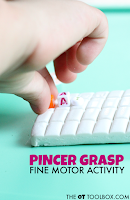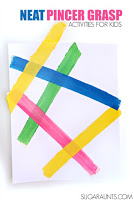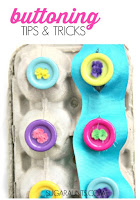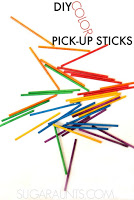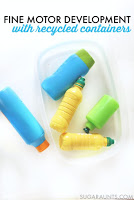The development of fine motor skills such as the pincer grasp is an important aspect of a baby’s growth and development. As a baby grows and gains more control over their movements, they begin to develop the ability to grasp objects with increasing precision. One of the most significant fine motor milestones in this journey is the emergence of the pincer grasp. This grasp enables babies to pick up small objects and use their fingers with greater finger dexterity, allowing them to explore their surroundings in new and exciting ways.
However, the functional use of a pincer grip doesn’t stop in babies and toddlers. Pincer grip use supports independent and manipulation of items with precision and dexterity and is an important part of fine motor work.
In this blog, we will delve deeper into the pincer grasp, exploring what it is, how it develops, and why it is such an important milestone for a baby’s growth and development.
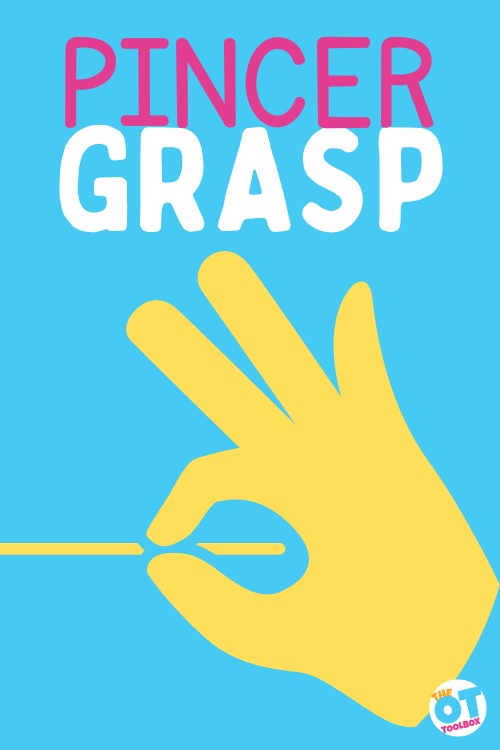
Amazon affiliate links are included in this blog post. As an Amazon Influencer, I earn from qualifying purchases.
What is Pincer Grasp?
The pincer grasp is a significant hand grasp that enables one to pick up and manipulate items with the tips of the fingers and is used to manipulate items such as small pieces of cereal or other little items. When we manipulate objects between the pad of the thumb to the pad of the pointer finger (index finger), we are using pincer grasp.
Pincer grip is essential for babies who are beginning to explore self-feeding with finger foods and begins to develop with the raking motion of the hands used to grasp at items such as food or cereal pieces. The hand eye coordination progression builds from here.
The raking grasp motion we see in young babies is actually a prerequisite to facilitate a pincer grasp development as the motion supports strengthening and coordination with all of the fingers, allowing for development of finger isolation in the index finger and thumb.
With the pincer grasp, the baby can pick up small items between the tips of their index and thumb fingers and bring them to their mouth.
Pincer grip can be broken down into types:
- Inferior pincer grasp- Also known as crude pincer grasp, or pad-to-pad grasp, the inferior pincer grasp uses the pads of the index and thumb to grasp objects.
- Pincer grasp- Slight flexion of the DIP joint of the index finger and IP joint of the thumb results in a round thumb web space. This grasp component utilizes the tips of these fingers.
- Neat pincer grasp- Also known as superior pincer grasp, Neat pincer grasp pulls the tips of the fingers in closer to the thumb web space and requires more flexion of the thumb IP joint and index finger DIP joint as well as flexion of the thumb MP joint and index PIP joint. Neat pincer grip is a more refined and dexterous grip used for extremely precise fine motor tasks such as picking up very small objects like a pin, thread, or sequin.
Development of Pincer Grasp
Pincer grip is one of the first dexterity skills to develop. The grasp pattern is a precision motor skill that emerges when a baby is between 8 to 10 months old and is guided by self-feeding and exploring objects through the primary sensory system at this young age: the mouth.
Inferior pincer grasp begins at 6-9 months. Before a true pincer grasp is established, you’ll notice a lateral pincer grasp, or an inferior pincer grasp. This progression begins as a raking motion from the fingers to grasp at the food pieces, but this movement is typically not successful in picking up small foods like baby puff snacks. The next stage of pincer grasp development progresses as the baby uses the lateral side of the index finger and the thumb to pick up small food pieces using the thumb and the side of the pointer finger to grasp items (not a true pincer grasp).
Pincer grasp develops around 9-12 months of age. This is when you see the baby pick up baby puffs and small chunks of food pieces to pick up the items with the thumb and the pad of the index finger.
Neat pincer grasp develops between 12-18 months and is a much finer skill. This is a common part of feeding developmental milestone achievement which allows babies to pick up and then feed themselves using that pincer grasp. This is when you will see babies pick up small crumbs from the carpet. Baby proofing takes on a whole new level once pincer grasp has developed!
Pincer Grasp Activities
We can use play-based pincer grasp activities to support this development based on the child’s age, development of these motor skills build independence, too. This pincer grasp activity supports precision needed to manipulate a pencil.
Pincer grasp and neat pincer grasp are precision fine motor skills that develop when babies start to pick up cereal in self-feeding. The developmental skill is essential for development of fine motor skills and manipulation of toys and items in play and discovery.
Try these pincer grasp activities:
- Stacking blocks
- Practice buttoning with buttons. Here are button activities to try.
- Build puzzles
- Play with nuts and bolts
- Open drawers with knobs
- Pound golf tees into an egg carton or hammering golf tees into the ground
- Flip pages of a board book
- Spray water with a spray bottle to strengthen the arches of the palm
- Color with small crayon pieces. Read more about the benefits of coloring.
- Play with play dough- Roll play dough into small balls and place onto a target. Use our play dough mats for inspiration.
- Bend pipe cleaners into different shapes
- Play with stickers. Read this resource on 10 reasons why every kid needs to play with stickers.
- Poke holes in a cardboard box and thread pipe cleaners into the holes.
- Press a pushpin into a lid of a container or cardboard box
- Use tongs to manipulate objects and sort craft pom poms by color
- Use tweezers to pick up cotton balls
- Tissue paper art- crumble tissue paper and dip into glue, then paste to paper
- Offer small food items in a cupcake pan
- Glue beans onto lines on paper
- Tread beads onto pipe cleaners or string
- Play with marbles (this marble slime activity is fun!)
- Water play with an eye dropper and colored water.
- Clip clothespins onto paper. These clothes pin ideas will give you more fun ways to build a stronger pincer grasp.
- Play with Cheerios or small pieces of cereal
- Build with LEGO blocks
- Play with wind-up toys
- String pasta onto yarn or pipe cleaners
- Geoboard and pegboards
What is Neat Pincer Grasp?
Neat pincer grasp is used to pick up very small items such as perler beads, a thread from a surface, or a needle. You might see the tip-to-tip grasp to pick up a sequin or fuzz from clothing.
Think about the “ok” sign with the thumb and pointer finger touching and a nice round “O” in the thumb web space. That tip-to-tip pinch is neat pincer grasp.
If neat pincer grasp is not developed, kids can potentially present with less thumb IP joint flexion and difficulty opening the thumb web space when manipulating very small items. This can lead to fumbling and decreased dexterity during fine motor tasks.
This post contains affiliate links.
Neat Pincer Grasp Activities
Neat pincer grasp uses the tips of the thumb and pointer finger to stabilize objects. When using a pincer grasp, children use the pads of the thumb and finger to stabilize the object.
- Pick up sequins
- Pick up toothpicks
- Stick embroidery thread to contact paper. Then pick up back up.
- Peel tape. Try this process art activity to stick and peel paint to address neat pincer grasp for fine motor skills.
- Pick up and peel stickers.
- Pick up and use very small beads like these 2 mm. glass beads (affiliate link) in crafts.
- Make crafts with fishing line.
- Create string art. (affiliate link)
- Try peeling tape in a group activity.
- Pick up small pasta in a sensory play activity.
- Pick up and manipulate pasta in a fine motor color match activity with play dough.
- Thread feathers.
- Pick up grass seed to work on letter formation. (Grass seed is very small!)
- Play with clothes pins to work on grasp.
- Drop thread into a sensory bottle.
These neat pincer grasp activities are creative ways that can help kids develop the small motor skill area.
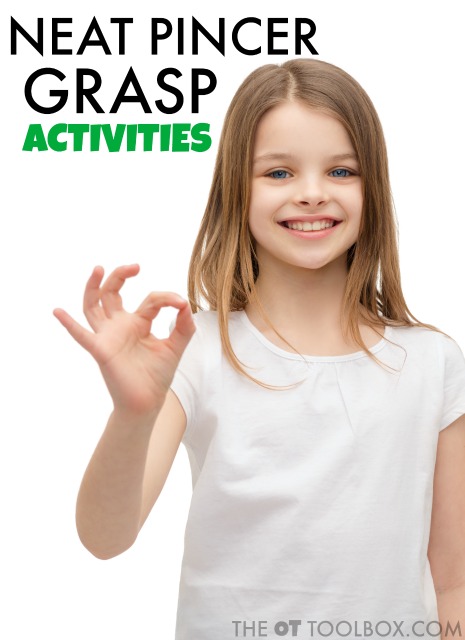
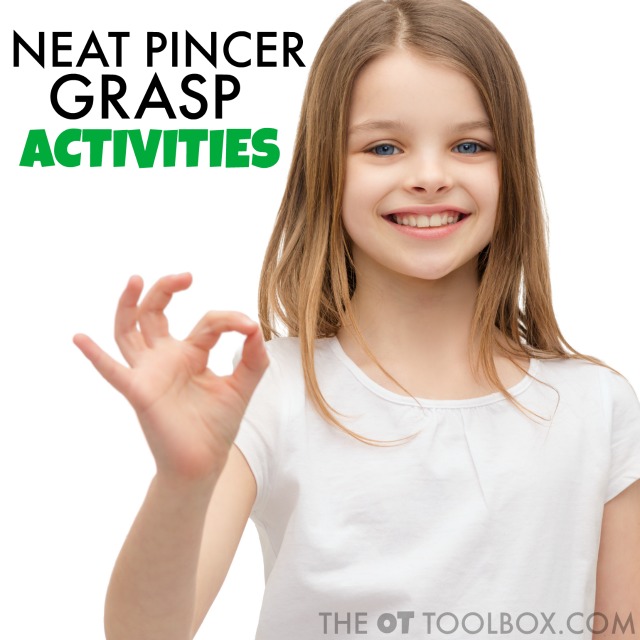
More fine motor skills you will love to explore:
- Pincer Grasp Fine Motor Activity
- Benefits of Stickers in Occupational Therapy
- Neat Pincer Grasp Fine Motor Activity
- Buttoning Tips and Tricks
- Travel Sensory Diet Bag
- Homemade Pencil Grip
- DIY Pick-Up Sticks
- Gross Grasp with Recycled Containers
- Finger Isolation Fingerprint Activities
In the Fine Motor Kits here on our website, you’ll find many precision activities that support development of pincer grasp. Specifically, there are tearing activities, crumbling activities, pinch activities, and other hand strengthening activities using themed fine motor activities.
Working on fine motor skills, visual perception, visual motor skills, sensory tolerance, handwriting, or scissor skills? Our Fine Motor Kits cover all of these areas and more.
Check out the seasonal Fine Motor Kits that kids love:






Or, grab one of our themed Fine Motor Kits to target skills with fun themes:
- Frogs Fine Motor Kit
- Unicorns Fine Motor Kit
- Vehicles Fine Motor Kit
- Apple Fine Motor Kit
- Back to School Kit
- Sports Fine Motor Kit
- Outer Space Fine Motor Kit
- Fairytale Fine Motor Kit
- Plus more in our shop!
Want access to all of these kits…and more being added each month? Join The OT Toolbox Member’s Club!

Colleen Beck, OTR/L has been an occupational therapist since 2000, working in school-based, hand therapy, outpatient peds, EI, and SNF. Colleen created The OT Toolbox to inspire therapists, teachers, and parents with easy and fun tools to help children thrive. Read her story about going from an OT making $3/hour (after paying for kids’ childcare) to a full-time OT resource creator for millions of readers. Want to collaborate? Send an email to contact@theottoolbox.com.


